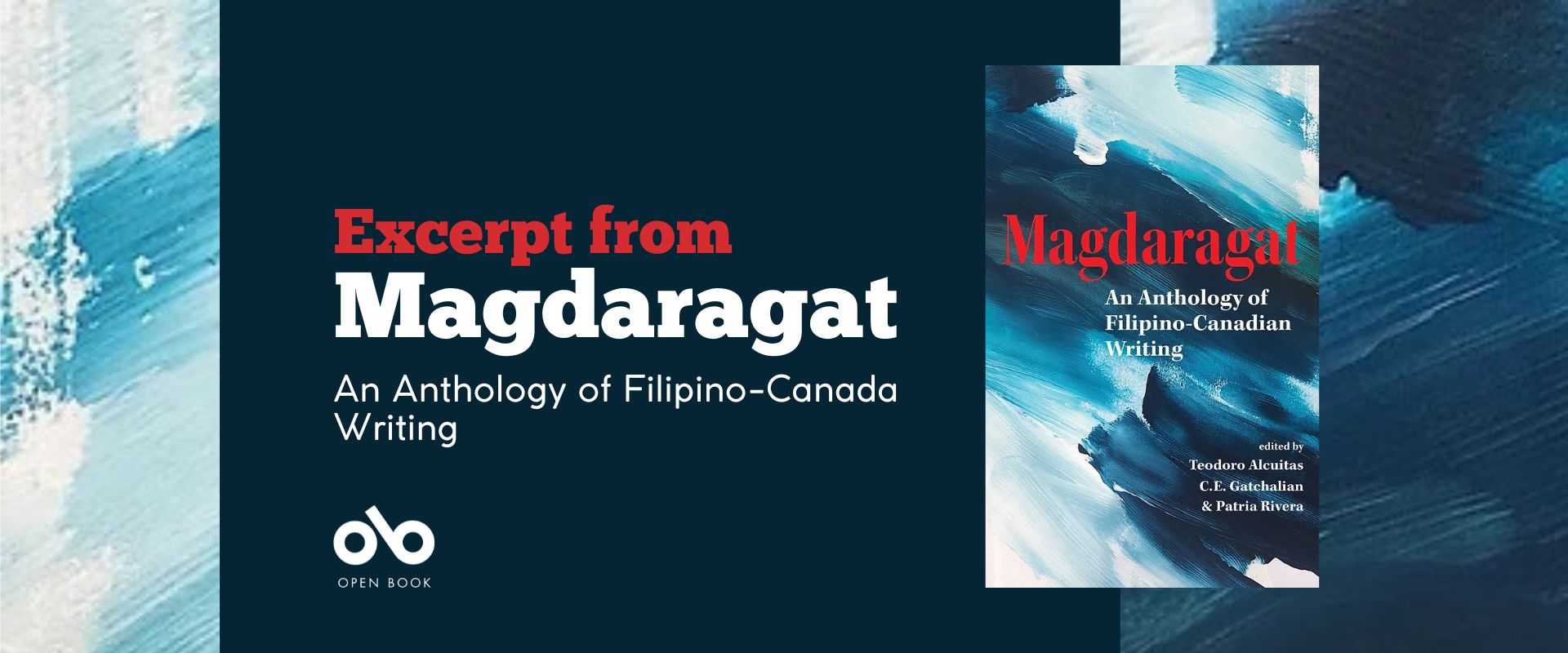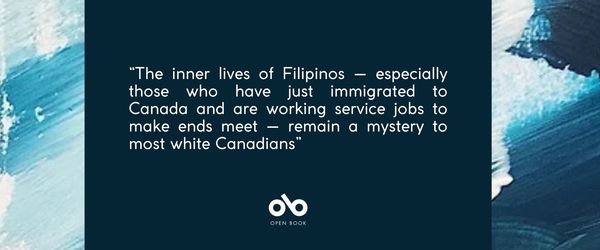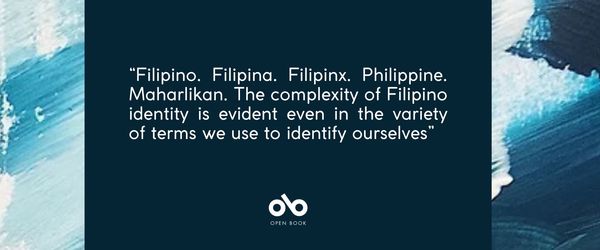Glimpse into the Wealth of Filipino-Canadian Writing Talent in this Excerpt from Magdaragat
Magdaragat: An Anthology of Filipino-Canadian Writing (Cormorant Books) opens with the line "Magdaragat is Filipino for 'seafarer' or 'mariner'". It's a first line that heralds the expansiveness of the collection and its ability to highlight the epic and often overlooked aspects of Filipino identity and history.
Edited by Teodoro Alcuitas, C.E. Gatchalian, and Patria Rivera, who also contribute to the volume, Magdaragat features more the 45 writers within its pages. They deftly explore Filipino-Canadian identities and experiences, a rich and complex past, and a future that highlights the diversity and strength of Filipino-Canadian people.
There have been Filipino people in Canada for more than 150 years, and their essential contributions have shaped our country. Often, like many racialized groups, their achievements have been minimized and appropriated. Magdaragat is the joyful resistance to that minimizing, a celebration and full-throated cry of pride at the strength and resilience, often in the face of discrimination and stereotypes, of of Filipino-Canadians and their invaluable place in the fabric of Canadian society.
We're sharing an excerpt from the book here today, in which the editors discuss the psychic and cultural role of the ocean in the Filipino diasporic experience and the subtle but important differences in the way Filipino people have experienced the influence of American culture vs. Canadian culture.
Excerpt from Magdaragat: An Anthology of Filipino-Canadian Writing:
Introduction
“[Filipinos are] mystic wanderers in the land of perpetual departures.”
— Karl Gaspar, author, professor, Redemptorist brother, Filipinologist
Magdaragat is Filipino for “seafarer” or “mariner.” Its dictionary meaning is straightforward enough, and even those with only cursory knowledge of the lands colonially known as “the Philippines” will understand why one would choose that word as the title for an anthology of Filipino diasporic writing. After all, the Philippines is an archipelago of approximately 7,000 islands in the South Pacific; the sea, as both literal and metaphorical entity, has dominated Filipino life — economically, politically, and culturally — since time immemorial.
The realities currently facing all folks of Filipino ancestry — both in the homeland and in the diaspora — deepen and complicate the idea of magdaragat. According to a 2022 study released by the Philippine government, approximately 1.83 million of the Philippines’ 110 million citizens were overseas Filipino workers (OFWS). In terms of “overseas Filipinos” — a broader term referring to people of Filipino ancestry, regardless of citizenship, who live outside the Philippines — the number jumps to approximately 12 million. The phenomena of Filipinos forced out of their homelands because of political corruption and poverty, and of Filipino women leaving their own children behind to care for others’ children abroad, are well documented. What isn’t as well documented is the extreme disconnection felt by many second-generation diasporic Filipinos — the children of Filipino immigrants — from the culture of their ancestral homeland, a disconnection intensified by colonialism and white supremacy. For second-generation Filipinos on Turtle Island (North America), the ocean is simultaneously that which divides us from, and binds us to, the homeland, whose shores many have never seen and whose culture and ethos have historically been denigrated.
Ocean, sea, water — apt metaphors, then, for the contemporary diasporic Filipino experience. Water as both separator and melder, as symbol of cultural fluidity, of the protean adaptability that is both our blessing and curse.
Filipinos on Turtle Island have a particularly complicated relationship with Filipino-ness. Of the 12 million diasporic Filipinos scattered on every continent of the globe (including Antarctica), more than a third live in North America. On Turtle Island is lodged the Philippines’ most recent colonizer — the United States (not counting the Japanese occupation of the islands during World War II), whose economic, political, and cultural influence on the Philippines continues to be overwhelming. Filipino-Americans wrestle regularly with the implications of holding citizenship in the colonizer’s country, one that has whitewashed Filipino cultural life with the blue-eyed goddesses and gods of Hollywood. This wrestling has spawned an impressive and almost century-long tradition of Filipino-American literature, boasting a number of award-winning, critically acclaimed books and plays.
Your CanLit News
Subscribe to Open Book’s newsletter to get local book events, literary content, writing tips, and more in your inbox
But what of Filipinos living north of the forty-ninth parallel? The Philippines’ relationship to the nation-state of Canada is far more oblique than the one it has to the United States. There is, of course, the commonality of language. Due to colonialism, both Canada and the Philippines are predominantly English-speaking countries. (With approximately 175 dialects scattered across its over 7,000 islands, English has become the Philippines’ default common language.) The two countries also — technically — share a common colonizer, Great Britain. (The British occupied Manila for twenty months in the mid-eighteenth century as part of the Seven Years’ War.) Far more importantly, they share a common cultural colonizer, the United States. But the conflict-laden, love-hate, Stockholm Syndrome aspects of the Philippines’ relationship with the United States are not found in its relationship with Canada. It’s the American Dream, after all, that Filipinos chase; Canada is the consolation prize if America, for whatever reason, doesn’t pan out.
While, according to historical records, the first Filipinos arrived in what would eventually become the United States in 1587, Filipinos didn’t arrive on Canadian shores (Bowen Island, BC, to be exact) until close to three centuries later, in 1861. In addition, Canada’s population is a tenth of the United States’. Filipino-Canadian history is, thus, of a smaller scope than Filipino-American history. But within that scope are issues unique to Filipinos in Canada that makes Fil-Can history a distinct subject in its own right, not merely an ancillary of Fil-Am history.
There is, to begin with, the different circumstances in which Filipinos arrived in Canada. While many Filipinos saw the United States as the logical destination for providing a better life for themselves and their families, they often “wandered into” Canada by accident, so the rationale for settling in Canada was more oblique and, therefore, less easily co-opted into predictable triumph narratives. To wit, stories of Filipino settlement in Canada are less burdened by ubiquitous abstractions like “the American Dream” and more grounded in the practical particulars of day-to-day survival.
Part of day-to-day survival are the physical conditions in which people live. For most Filipino immigrants, the most jarring thing about moving to Canada is adjusting to the climate. Much of Canada is buried in snow for six months (or more) of the year. In a stunning stroke of irony, the oldest —and still, by percentage of the population, largest — Filipino community is in Winnipeg, jokingly nicknamed “Winterpeg” because of its extraordinarily harsh and long winters. That a tropical people would be found in significant numbers in such a locale may be fodder for comical narratives but is, more significantly, a testament to this sombre fact: that desperation for a better life has led Filipinos to self uproot even to climates that are the complete opposite of what they are familiar with.
Another, more insidious, survival issue Filipinos in Canada have to navigate: the passive-aggressive racism of white Canadians. The brazenness of white American racism is well documented (and spotlighted and hyperscrutinized because of the United States’ status as an imperial power); in contrast, white Canadian racism often slips under the radar because it is more typically characterized by microaggressions. The favourite Canadian refrain vis-avis racism — “We’re not as bad as Americans” — constitutes what might be called “maple-washing”: the relentless washing over of all instances of Canadian racism with the claim that it’s still not as horrible as what has transpired in the United States. Accordingly, the racism Filipinos in Canada experience — and which makes its way into some of the pieces in this anthology — is more insidious than its American counterpart and is characterized by shocking ruptures in a strenuously maintained politesse.
As mentioned, Filipino-Canadian history — and activism — is much younger than Filipino-American history; therefore, the evolution from playing supporting roles in white people’s stories to leading roles in Filipino-centric ones is, inevitably, at least two decades behind the American trajectory.
Supporting players in white people’s stories. Certainly, north of the forty-ninth parallel, the image most white people have of Filipinos is that of caregivers of various kinds (nurses, housekeepers, nannies). White Canadians have, in general, a benign view of Filipinos as cheerful, friendly, family-oriented, and unthreatening. (“Good Christians” is a descriptor most Filipino-Canadians have heard at one point or another.) Other comments commonly heard about Filipinos, all lifted from the lived experiences of this book’s editors, include:
“Filipino women are loyal and faithful.”
“I love how Filipino people are always smiling.”
“I so admire how Filipinos always send money back to their families in the Philippines.”
“Why is everyone trashing the nanny program? I was raised by a Filipino nanny and she was happy to work for us. I’m glad that we could provide her with a better life.”
White people — alongside privileged, “white-adjacent” non-whites — even “thingify” Filipinos. A friend of a member of the editorial team mentioned how, at the hospital in which they worked as a nurse, a colleague once asked the head of a white family whose matriarch was being released if they required an in-house nurse. “No, we’re fine,” replied the head. “We have a Filipino at home.”
The inner lives of Filipinos — especially those who have just immigrated to Canada and are working service jobs to make ends meet — remain a mystery to most white Canadians. For example, the majority have little to no idea of the high levels of education Filipinos typically achieved prior to arriving in this country; many were practising doctors, lawyers, or architects in the Philippines. It’s lives of personal agency and fulfillment — not ones dedicated to caring for others in wealthy foreign countries — that most Filipinos hope and train for. But extreme poverty in the homeland — exacerbated by corrupt politicians embezzling money from the public coffers and a World Bank unforgiving of debts that its own colonial projects caused, layered over by an ongoing pas de deux with post-colonial melancholia — have driven Filipinos overseas, taking all varieties of work to survive. Thus, the widespread conception of Filipinos as “supporting players,” happy to take on the jobs no one else wants because of our humble and self-effacing natures.
What’s ultimately effaced is the truth behind the smiles we’re known for: the stories of our parents, grandparents, and great-grandparents, informed by the colonial trauma every Filipino carries in their DNA — so many stories buried under the rubble of colonialism, under the smiles we wear out of regard for others.
The Filipino word hiya is a core concept in Filipino psychology. As Filipino psychologist Dr. Elizabeth de Castro explains, “Hiya, literally translated, again by Western scholars, is ‘shame.’ If you are ashamed, you must have sinned. If you sin, then you are guilty. If you are guilty, then... you have to apologize. If you apologize then there is repentance or penance. Down the line of the sin, guilt, and repentance framework. And that is why we are all feeling guilty. But hiya is not that. It is a kind of sensitivity, a sense of propriety in order to not offend the other. Actually, hiya is not easy to translate — there is no one word translation.
A language is not only a means of communication; it is a manifestation of a world view. White colonizers who learned Filipino but understood little to nothing of the indigenous Filipino world view interpreted hiya in a manner inflected by Western Christianity. So, with the passage of time and the consolidation of white supremacy in the islands — resulting in colonizers teaching us their version of Filipino culture — hiya came to denote something very different from its original meaning. As mentioned, the word is now commonly understood to mean “shame,” and to be walang hiya, or “without shame,” is a major moral transgression. One of the most enduring consequences of colonialism has been our collective inferiority complex, so shame has come to be not only about things we do, but who we are.
The poems, stories, essays, think pieces, speeches, and plays that comprise this anthology are textured testimonies to all that we are, the full humanity of an uprooted and traumatized people creating a syncretic culture from the rubble of melancholia and displacement.
The COVID-19 pandemic brought the world to a virtual standstill. In that standstill, issues customarily lost in the static of capitalist colonialism got overdue airtime: the durability of white supremacy, manifesting, on Turtle Island, in anti-Indigenous, anti-Black, and anti-Asian racisms.
As Asians, Filipino-Canadians were not exempt from the harm caused by the broad stroke perception of covid as an “Asian” disease; furthermore, as a disproportionately large percentage of front line labourers in general and health care workers in particular, Filipinos played a significant role in keeping Canadian society going during the pandemic. To be simultaneously demonized and heroized, after decades of invisibility, had yet another displacing effect on an already chronically displaced community. A positive consequence of this has been a new — or renewed — motivation to assert one’s Filipinoness — most especially of the “pure” ilk, that which pre-existed Spanish and American colonization. No doubt this indigenizing shift has been greatly inspired by #LandBack and other Indigenous rights movements, which were foregrounded dramatically in the midpoint of the pandemic with the discovery of the unmarked graves of residential school children.
Needless to say, this emphasis on “purity,” with its eugenic connotations, is deeply problematic, but it generates a more quotidian question: is there even such a thing as a “pure Filipino”? The question is mostly rhetorical (science has proven that the notion of absolute racial and ethnic purity is a supremacist pipe dream) but, for Filipinos, can serve as a framework in which to think about identity.
To begin with, the term “Filipino” is itself colonial, derived from the name imposed on the islands by Spanish conquerors, so the phrase “pure Filipino” is conceptually nonsensical. But, more importantly for our purposes, the majority of Filipinos are ancestrally multi-ethnic, a mix of the peoples indigenous to the islands with the traders and, later, the colonizers who settled there. The resultant culture is similarly mixed, a syncretism of the world views and life practices of these peoples. (Just a few examples: indigenous animism melding with Roman Catholicism, American Protestantism, Hinduism, and Islam; Chinese, Japanese, and Indian influences peppering native culinary traditions; languages native to the islands absorbing Spanish and English genderedness, expressions, and words.) Most Filipinos still have Spanish surnames, thanks to the Spanish colonial requirement that all natives take Spanish names for tax registration purposes. To further complicate matters, in the Philippines the term “indigenous” is used differently from what we are accustomed to in North America, applying specifically to members and descendants of tribes that resisted Spanish colonization and who have remained in their ancestral domains. Since most Filipinos do not trace their ancestries to these tribes, the majority of Filipinos are, in this context, “non-indigenous” to their own land. Readers can extrapolate for themselves the social, cultural, and psychological implications of this formulation.
Filipino. Filipina. Filipinx. Philippine. Maharlikan. The complexity of Filipino identity is evident even in the variety of terms we use to identify ourselves. Filipino and Filipina remain the most used in common parlance. However, many younger and academically inclined diasporic Filipinos are opting out of those terms, pointing to their genderedness as remnants of Spanish colonization (virtually all languages indigenous to the islands are non-gendered), as well as expressing solidarity with queer-identifying Filipinos alienated by the Western gender binary. This awareness has given rise to the term Filipinx, inspired by the term Latinx, increasingly used by people of Latin American ancestry for similar reasons. The push back against Filipinx is that it, too, is a Western imposition, as the letter x doesn’t exist in the Filipino alphabet and the Filipino language already demonstrates gender neutrality. Philippine — a derivative of the name of the sixteenth-century Spanish monarch in power when Spain colonized the islands (Philip II) — is, of course, laden with colonialism and no longer commonly used as an identifier. Maharlikan comes from the term Maharlika, which refers to the feudal warrior class in ancient, pre-colonial Filipino society. While its pre-colonial origins may seem compatible with the drive to indigenize, its close association with right-wing Filipino nationalism, in particular former President Ferdinand Marcos (who advocated changing the country’s name to Maharlika, as did, decades later, populist President Rodrigo Duterte), causes extreme wariness among liberal and progressive Filipinos. Others eschew broad national modifiers altogether and root themselves to specific tribal ones, such as Tagalog, Ilocano, and Visayan.
_______________________________________________________
Excerpted from Magdaragat: An Anthology of Filipino-Canadian Writing, edited by Teodoro Alcuitas, C.E. Gatchalian, and Patria Rivera. Introduction, author biographies, and selection copyright 2023 Teodoro Alcuitas, C.E. Gatchalian, and Patria Rivera. Excerpted with permission.
Teodoro Alcuitas is the publisher and editor of Philippine Canadian News, an online paper linking the Filipino diaspora. He lives in Vancouver, British Columbia.
C.E. Gatchalian is the author of six books and co-editor of two anthologies. He is a three-time Lambda Literary Award finalist and received the Dayne Ogilvie Prize in 2013 from the Writers’ Trust of Canada. He was a recipient of a British Columbia Lieutenant Governor’s Arts & Music Award in 2022. He lives in Toronto, Ontario.
Patria Rivera’s first poetry collection, Puti/White, was shortlisted for the 2006 Trillium Book Award for Poetry. She has also published The Bride Anthology, BE, and The Time Between, and co-authored two chapbooks: Six from the Sixth and Weathering: An Exchange of Poems. She lives in the east end of Toronto, Ontario.





